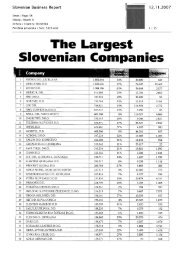The Group KD Group and KD Group dd
The Group KD Group and KD Group dd
The Group KD Group and KD Group dd
Create successful ePaper yourself
Turn your PDF publications into a flip-book with our unique Google optimized e-Paper software.
<strong>The</strong> <strong>Group</strong> <strong>KD</strong> <strong>Group</strong> Annual Report 2009<br />
Notes to Consolidated Financial Statements as at <strong>and</strong> for the year ended 31 December 2009<br />
2.8.4.2. Measurement of financial assets<br />
Available-for-sale financial assets <strong>and</strong> financial assets at fair value through profit or loss are subsequently carried at fair value.<br />
Loans <strong>and</strong> receivables <strong>and</strong> held-to-maturity investments are carried at amortised cost using the effective interest method.<br />
Gains <strong>and</strong> losses arising from changes in the fair value of the "financial assets at fair value through profit or loss" category are<br />
included in the income statement in the period in which they arise. Gains <strong>and</strong> losses arising from changes in the fair value of<br />
available-for-sale financial assets are recognised directly inother comprehensive income, until the financial asset is<br />
derecognised or impaired. At this time, the cumulative gain or loss previously recognised in equity is recognised in profit or<br />
loss. However, interest calculated using the effective interest method <strong>and</strong> foreign currency gains <strong>and</strong> losses on monetary<br />
assets classified as available for sale are recognised in the income statement. Dividends on available-for-sale equity<br />
instruments are recognised in the income statement when the entity’s right to receive payment is established.<br />
<strong>The</strong> fair values of investments listed on active markets are based on current bid prices. If there is no active market for a<br />
financial asset, the <strong>Group</strong> establishes fair value using valuation techniques. <strong>The</strong>se include the use of recent arm’s length<br />
transactions, discounted cash flow analysis <strong>and</strong> other valuation techniques commonly used by market participants.<br />
2.9 Impairment of assets<br />
2.9.1 Impairment of financial assets<br />
(a) Financial assets carried at amortised cost<br />
<strong>The</strong> <strong>Group</strong> assesses at balance sheet date whether there is objective evidence that a financial asset or group of financial<br />
assets is impaired. A financial asset or a group of financial assets is impaired <strong>and</strong> impairment losses are incurred if, <strong>and</strong> only<br />
if, there is objective evidence of impairment as a result of one or more events that occurred after the initial recognition of the<br />
asset (a "loss event") <strong>and</strong> that a loss event (or events) has an impact on the estimated future cash flows of the financial asset<br />
or group of financial assets that can be reliably estimated. Objective evidence that a financial asset or group of assets is<br />
impaired includes observable data that comes to the attention of the <strong>Group</strong> about the following loss events:<br />
• significant financial difficulty of the issuer;<br />
• a breach of contract, such as a default or delayed payement of interest or principal amount;<br />
• the <strong>Group</strong> granting to the borrower, for economic or legal reasons relating to the borrower’s financial difficulty, a<br />
concession that the lender would not otherwise consider;<br />
• it is becoming probable that the borrower will enter bankruptcy or other financial reorganisation;<br />
• the disappearance of an active market for that financial asset because of financial difficulties; or<br />
• observable data indicating that there has been a measurable decrease in the estimated future cash flows from a<br />
group of financial assets since the initial recognition of those assets, although the decrease cannot yet be identified<br />
with the individual financial assets in the <strong>Group</strong>, including:<br />
- adverse changes in the payment status of borrowers in the <strong>Group</strong>; or<br />
- national or local economic conditions that correlate with defaults on the assets in the <strong>Group</strong>.<br />
<strong>The</strong> <strong>Group</strong> first assesses whether objective evidence of impairment exists individually for financial assets that are individually<br />
significant. If the <strong>Group</strong> determines that no objective evidence of impairment exists for an individually assessed financial<br />
asset, whether significant or not, it includes the asset in a group of financial assets with similar credit risk characteristics <strong>and</strong><br />
collectively assesses them for impairment. Assets that are individually assessed for impairment <strong>and</strong> for which an impairment<br />
loss is or continues to be recognised are not included in a collective assessment of impairment.<br />
If there is objective evidence that an impairment loss on loans <strong>and</strong> receivables or held-to-maturity investments carried at<br />
amortised cost has been incurred, the amount of the loss is measured as the difference between the asset’s carrying amount<br />
<strong>and</strong> the present value of estimated future cash flows (excluding future credit losses that have not been incurred) discounted at<br />
the financial asset’s original effective interest rate. <strong>The</strong> carrying amount of the asset is reduced through the use of an<br />
allowance account <strong>and</strong> the amount of the loss is recognised in the income statement. If a loan or held-to-maturity investment<br />
has a variable interest rate, the discount rate for measuring any impairment loss is the current effective interest rate<br />
determined under the contract. As a practical expedient, the <strong>Group</strong> may measure impairment on the basis of an instrument’s<br />
fair value using an observable market price. <strong>The</strong> calculation of the present value of the estimated future cash flows of a<br />
collateralised financial asset reflects the cash flows that may result from foreclosure less costs for obtaining <strong>and</strong> selling the<br />
collateral, whether or not foreclosure is probable.<br />
94







